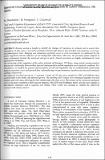Por favor, use este identificador para citar o enlazar a este item:
http://hdl.handle.net/10261/95098COMPARTIR / EXPORTAR:
 SHARE
BASE SHARE
BASE
|
|
| Visualizar otros formatos: MARC | Dublin Core | RDF | ORE | MODS | METS | DIDL | DATACITE | |

| Título: | Spectral characteristics of soil and vegetation in saline wetlands, NE Spain |
Autor: | Domínguez-Beisiegel, Manuela; Mougenot, Bernard; Castañeda del Álamo, Carmen CSIC ORCID | Fecha de publicación: | 2010 | Editor: | Universidad de Valencia | Citación: | Domínguez M. Mougenot B, Castañeda del Álamo, C, Spectral characteristics of soil and vegetation in saline wetlands, NE Spain. In: Third Recent Advances in Quantitative Remote Sensing (Sobrino JA, dir.), pp.: 143-148 (2010) | Resumen: | Remote sensing is heipful to identfy the cha ges of vegetation in wetlands and to assess their degradation. In this sense, is crucial to establish a relationship between spectral date and vegetation cover; type and phenological state. Mapping and estimating vegetation cover in arid environments is conditioned by the sparse vegetation and the influence of soil background reflectance. Moreover the perennial plants adapted to saline environment include dry, senescent and green parts. Annual specimens are highly conditioned by local and seaonal variations. The rnonitoring of the vegetation of the saline wetlands of Monegros, NE Spain, using remote sensing requires knowing the relationship between their spectral characteristics and the vegetation cover and sol! conditions. For this purpose, we studied the spectrai characteristics of soils and vegetation and we established the relationship beween vegetation cover and spectral data collected using two spectrometers, based on discrete and continuous readings, respectiveiy. We conducted two fleid surveys in 11 wetlands. A total of 242 sites were sampled in 2007 and 2008 fo their spectral study in the visible and infrared spectra. The resulting NDVI values were interpreted together with soil moisture and color data, allowing for their relationship with plant cover. The mixture of dry, senescent and green parts In the plant contribute to their spectral response. The NDVJ and Brightness Index were the most saltable to discriminate vegetation and to separate soil ciasses. These results are essential to validate the reflectivity measured with remote sensors. | Descripción: | 6 Pags.- 4 Figs. Book from the Third International Symposium on Recent Advances in Quantitative Remote Sensing (Torrent, Spain. September 27 to October 1, 2010). It was sponsored and organized by the Global Change Unit (GCU) from the Image Processing Laboratory (IPL), University of Valencia (UVEG), Spain. | URI: | http://hdl.handle.net/10261/95098 | Identificadores: | isbn: 978-84-370-7952-3 |
| Aparece en las colecciones: | (EEAD) Libros y partes de libros |
Ficheros en este ítem:
| Fichero | Descripción | Tamaño | Formato | |
|---|---|---|---|---|
| CastanedaC_CapLib_2010.pdf | 1,13 MB | Adobe PDF |  Visualizar/Abrir |
CORE Recommender
Page view(s)
325
checked on 24-abr-2024
Download(s)
105
checked on 24-abr-2024
Google ScholarTM
Check
NOTA: Los ítems de Digital.CSIC están protegidos por copyright, con todos los derechos reservados, a menos que se indique lo contrario.
